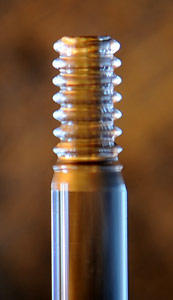Frequency Combs
The Technology

When applications demand ultra-precise high-frequency measurements, many rely on frequency comb technology, invented and developed at NIST.
Now NIST scientists are taking the technology to unprecedented levels of accuracy in chip-scale dimensions, pioneering novel designs for an expanded range of applications. They deliver high-precision optical output in small, low-power, relatively inexpensive, portable forms using components that can be produced by microfabrication techniques already extensively employed in industry.
Until recently, frequency combs were generated by conventional mode-locked lasers that generate a sequence of precisely evenly spaced frequencies that serve as an optical “ruler.” In recent years a new optical frequency comb generation principle has emerged that instead utilizes parametric oscillation in high-Q microresonators — small circular waveguides that form a sort of closed racetrack for light injected into the resonator from adjustable continuous wave pump lasers.
Some waveguide rings circle fused silica pillars in the range of 2 mm wide; some are microfabricated with channel diameters around 40-50 µm. Both employ total internal reflection to guide light in a circular path. For microcombs, from 200 to 2,000 wavelengths fit in the cavity.
These microcombs amplify the intensity of the light circulating in them and operate on a tiny fraction of the power required for tabletop lasers.
This approach not only offers compactness and chip-scale integration, but also provides direct access to high repetition rates in the range of 10-1000 GHz.
Advantages Over Existing Methods
The research offers an appealing alternative to the way frequency combs have typically been generated — by complicated, specially configured tabletop lasers that put out a train of high-frequency light pulses. Microcombs, by contrast, are many orders of magnitude smaller and thus well suited to applications where spaces are tight and power is limited. An important aspect of microcombs is that they offer the potential for full photonic integration. Instead of a frequency comb being built by hand with multiple components, a microcomb system will one day be fabricated like a present-day computer chip. Thus, they are not only small and low power, but they could be ubiquitously deployed at very low cost.
NIST scientists expect that compact optical combs will eventually make possible ultraprecise sensors of time, fields, forces and more based on the interaction of light and matter. For end users, they could make integrated combs and timekeeping so easy, small, inexpensive and accessible that it could be used in practically any situation.
Applications
Frequency combs are now or soon will be widely deployed in a number of important and often critical applications. These include making precision long-distance position measurements, analyzing ultra-high data rate communications for 5G and beyond, testing the systems used to reveal properties of biological and other molecules by their reaction to light, calibrating instruments that detect electromagnetic emissions from outer space, detecting methane leaks in oil and gas production, and measuring the amount of various atmospheric gases (such as the greenhouse gas carbon dioxide).
The same process can also be used to check for extremely fine-scale variations in microwave sources with GHz frequencies. These include the atomic clocks that provide U.S. official time or the signals from GPS satellites, by comparing their output to reference combs with frequencies 1,000 or more times higher. And it makes possible optical clocks with “tick” rates about 100,000 times faster than microwave models.
Key Papers
P. Del’Haye, A. Coillet, T. Fortier, K. Beha, D.C. Cole, K.Y. Yang, H. Lee, K.J. Vahala, S.B. Papp and S.A. Diddams. Phase-coherent microwave-to-optical link with a self-referenced microcomb. Nature Photonics. June 6, 2016. DOI: 10.1038/nphoton.2016.105
Q. Li, T.C. Briles, D.A. Westly, T.E. Drake, J.R. Stone, B.R. Ilic, S.A. Diddams, S.B. Papp and K. Srinivasan. Stably accessing octave-spanning microresonator frequency combs in the soliton regime. Optica. Feb. 2, 2017. DOI: 10.1364/OPTICA.4.000193
T.C. Briles, J.R. Stone, T.E. Drake, D.T. Spencer, C. Fredrick, Q. Li, D. Westly, B.R. Ilic, K. Srinivasan, S.A. Diddams and S.B. Papp. Interlocking Kerr-microresonator frequency combs for microwave to optical synthesis. Optics Letters. June 14, 2018. DOI: 10.1364/OL.43.002933
D.C. Cole, E.S. Lamb, P. Del’Haye, S.A. Diddams and S.B. Papp. Soliton crystals in Kerr resonators. Nature Photonics. Sept. 25, 2017. DOI: 10.1038/s41566-017-0009-z
S.-P. Yu, T.C. Briles, G.T. Moille, X. Lu, S.A. Diddams, K. Srinivasan and S.B. Papp. Tuning KerrSoliton Frequency Combs to Atomic Resonances. Physical Review Applied. April 5, 2019. DOI: 10.1103/PhysRevApplied.11.044017
Z.L. Newman, V. Maurice, T.E. Drake, J.R. Stone, T.C. Briles, D.T. Spencer, C. Fredrick, Q. Li, D. Westly, B.R. Ilic, B. Shen, M.-G. Suh, K.Y. Yang, C. Johnson, D.M. S. Johnson, L. Hollberg, K. Vahala, K. Srinivasan, S.A. Diddams, J. Kitching, S.B. Papp and M.T. Hummon. Architecture for the photonic integration of an optical atomic clock. Optica. May 20, 2019. DOI: 10.1364/OPTICA.6.000680
Key Patents
K. Vahala et al. Optical frequency measurement and control using dual optical-frequency combs. United States Patent Application US 20180095003. April 5, 2018.
S. Papp et al. Electronic light synthesizer and process for electronically synthesizing light. United States Patent Application US 20170277017. Sept. 28, 2017.
S. Diddams et al. Laser machining and mechanical control of optical microresonators. United States Patent US 9,341,781. May 17, 2016.
Contacts
-
(303) 497-7459

